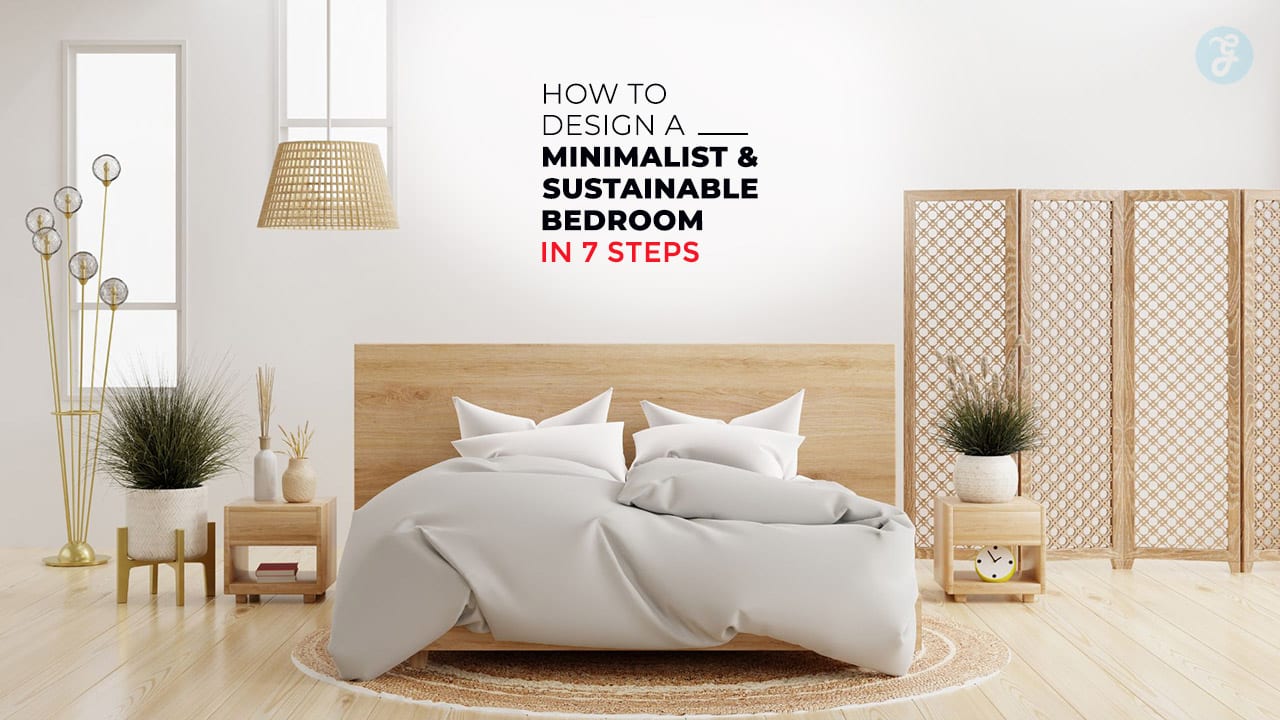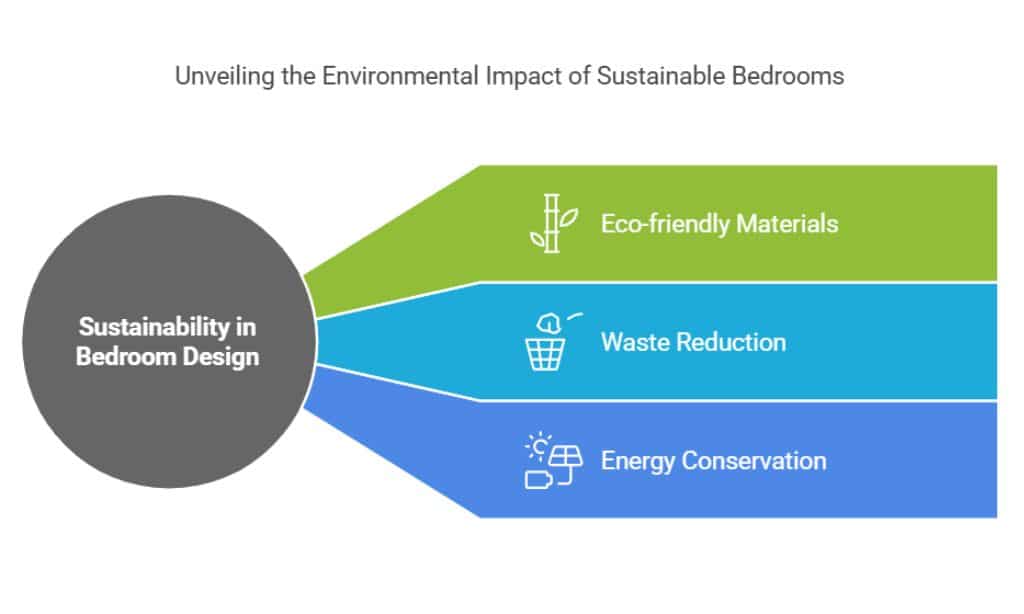In a world increasingly focused on conscious living, creating a minimalist and sustainable bedroom allows you to live with intention, reduce your environmental footprint, and foster peace of mind.
A minimalist approach isn’t just about reducing possessions—it’s about curating a space that feels intentional, calm, and organized, while sustainability ensures the long-term health of our planet.
This article provides you with a comprehensive guide on how to transform your bedroom into a minimalist and sustainable bedroom. With actionable tips and expert insights, we’ll walk you through the seven essential steps, including decluttering, furniture choices, and lighting strategies that focus on environmental well-being. Let’s dive in!
Why a Minimalist and Sustainable Bedroom?
Before diving into the design steps, it’s essential to understand the profound benefits of combining minimalist and sustainable design principles in your bedroom. These practices contribute not only to a peaceful, organized space but also play a vital role in reducing your ecological footprint.
Benefits of Minimalist Design in Your Bedroom
Minimalism creates a serene, uncluttered space that fosters clarity and peace. A minimalist and sustainable bedroom allows you to prioritize function and beauty, making your room feel like a sanctuary for rest and rejuvenation. Key benefits of minimalism include:
- Increased Mental Clarity: Reducing clutter reduces mental chaos, allowing for improved focus and relaxation.
- More Space to Breathe: A minimalist space feels open and spacious, enhancing comfort and reducing stress.
- Improved Maintenance: Fewer items in your bedroom mean less cleaning and more time to relax.
How Sustainable Bedroom Design Contributes to the Environment
Sustainability in bedroom design doesn’t just benefit your health and peace of mind—it’s a powerful tool to help reduce the impact of human activity on the environment. Incorporating sustainable practices in your bedroom design involves selecting eco-friendly materials, reducing waste, and conserving energy. Some important environmental benefits include:
- Less Waste: Choosing durable, high-quality materials means fewer replacements and reduced landfill waste.
- Energy Conservation: Using energy-efficient appliances and lighting helps reduce energy consumption, lowering your carbon footprint.
- Support for Ethical Brands: By purchasing sustainably made products, you’re supporting brands that prioritize ethical production and fair labor practices.
Step 1: Declutter and Simplify Your Space
A cluttered bedroom can contribute to mental stress and overwhelm. The first step to designing a minimalist and sustainable bedroom is decluttering and simplifying your space. This process allows you to focus on what truly matters and contributes to a more peaceful and organized environment.
Assess Your Current Bedroom Layout
Take stock of your bedroom’s current state. Are there items you rarely use? Do you feel like you have too much furniture or decor that doesn’t serve a function? Begin by organizing your space and deciding what truly needs to stay.
How to Assess Your Bedroom:
- Furniture: Is each piece necessary, or could you swap it for something more functional?
- Decor: Do you have excessive decor items that don’t bring value or meaning to the space?
- Storage: Is your bedroom overly stuffed with items that could be stored elsewhere?
Create a Plan for Simplification
Simplifying your space is a thoughtful process that requires time and patience. There are several strategies you can use to make this task more manageable.
Effective Decluttering Methods:
| Method | Description | Ideal For |
| KonMari Method | Tidy by category (clothes, books, etc.) and only keep what sparks joy. | People who are sentimental about possessions. |
| One In, One Out | For every new item, get rid of something old. | Those who want ongoing control over clutter. |
| Four-Box Method | Use four boxes labeled “keep,” “donate,” “trash,” and “relocate” to organize and make decisions. | People who prefer a hands-on approach and need clear sorting. |
Implementing one of these methods ensures that only the items which truly contribute to your minimalist and sustainable bedroom remain.
Step 2: Choose Eco-Friendly, Minimalist Furniture
When designing a minimalist and sustainable bedroom, selecting the right furniture is essential. Sustainable furniture is crafted from eco-conscious materials, reducing both waste and your environmental impact.
Selecting Sustainable Materials
Choosing eco-friendly furniture starts with understanding the materials used. Sustainable materials like bamboo, reclaimed wood, and cork have minimal environmental impact compared to conventional options.
Top Sustainable Materials for Bedroom Furniture:
| Material | Benefits | Example Products |
| Bamboo | Fast-growing, renewable, and highly durable. | Bamboo bed frames, nightstands, and storage solutions. |
| Reclaimed Wood | Repurposed wood from old buildings or furniture. | Vintage dressers or side tables made from salvaged wood. |
| Cork | Biodegradable, lightweight, and renewable. | Cork lamps, desks, and shelving units. |
Opt for Multi-Functional Furniture
Multi-functional furniture serves both minimalist and sustainable purposes. It reduces the need for extra items, helping you save space while maintaining a clean, uncluttered look.
Examples of Multi-Functional Furniture:
- Storage Beds: Beds with built-in storage underneath can help minimize clutter and reduce the need for additional furniture like dressers or storage bins.
- Convertible Desks: Desks that transform into a vanity or fold down when not in use.
- Modular Shelves: Adjustable and modular shelving units that can adapt to changing storage needs.
By investing in multi-functional furniture, you ensure that every item in your minimalist and sustainable bedroom serves a practical purpose.
Step 3: Use a Neutral Color Palette
The color scheme of your minimalist and sustainable bedroom is an important aspect of setting the tone for a calm, peaceful space. Neutral colors promote relaxation and work well with sustainable materials, making them perfect for minimalist design.
Why Neutral Colors Create a Calm, Inviting Space
Neutral shades like whites, soft grays, and beiges are timeless, calming, and versatile. These colors create a peaceful environment that invites rest and relaxation, which is exactly what you need in a bedroom.
Psychological Benefits of Neutral Colors:
- Whites and Off-Whites: Promote purity, freshness, and simplicity.
- Soft Grays and Beiges: Provide a calming, balanced atmosphere without overwhelming the senses.
- Earth Tones (Greens, Browns): Encourage connection to nature, reinforcing sustainable values.
Color Combinations for a Sustainable Bedroom
When selecting colors for your minimalist and sustainable bedroom, it’s important to pair them with natural, eco-friendly materials for a cohesive look.
| Base Color | Accent Color | Sustainable Material |
| White | Light Gray | Organic Cotton Bedding |
| Beige | Soft Green | Recycled Wood Furniture |
| Light Gray | Natural Wood | Hemp Curtains |
| Soft Blue | White | Bamboo Rugs |
A cohesive color scheme combined with sustainable materials enhances both the minimalist and eco-friendly vibe of your space.
Step 4: Incorporate Natural Lighting
Natural light is a key element in any minimalist and sustainable bedroom. Not only does it reduce your reliance on artificial lighting, but it also creates a connection with nature, making the space feel more open and inviting.
Maximize Natural Light with Simple Design Choices
To make the most of natural light, avoid heavy curtains and blockages. Instead, focus on letting the light flow freely into your space.
Design Tips to Maximize Natural Light:
- Sheer Curtains: Choose lightweight fabrics like linen or cotton for window treatments that allow light to filter in while offering privacy.
- Strategic Furniture Placement: Place furniture near windows to capture natural light. Avoid placing bulky furniture in front of windows.
- Use Reflective Surfaces: Light-colored walls and furniture help reflect natural light and brighten the room.
Sustainable Lighting Options for Minimalist Design
For evening lighting, choose energy-efficient options that align with the minimalist aesthetic.
Energy-Efficient Lighting Options:
- LED Bulbs: Use up to 80% less energy and last up to 25 times longer than traditional incandescent bulbs.
- Solar-Powered Lamps: Ideal for sustainable lighting, these lamps rely on solar energy, which reduces electricity consumption.
- Dimmable Fixtures: Control light levels based on the time of day, reducing energy waste.
These lighting strategies allow you to create a bright, eco-conscious space that reduces your energy consumption and reliance on artificial lighting.
Step 5: Choose Sustainable Textiles and Bedding
Textiles are a significant part of bedroom design, and choosing the right fabrics can greatly enhance the sustainability of your minimalist and sustainable bedroom.
The Importance of Organic and Recycled Fabrics
Organic and recycled fabrics have a smaller environmental footprint than conventional textiles. By choosing these materials, you’re contributing to a cleaner planet.
Eco-Friendly Bedding Materials:
| Material | Benefits | Example Products |
| Organic Cotton | Grown without harmful pesticides. | Organic cotton sheets, duvet covers, and pillowcases. |
| Hemp | Requires little water and no pesticides. | Hemp blankets, throws, and bed linens. |
| Recycled Polyester | Made from plastic waste, reducing landfill waste. | Recycled polyester cushions and throws. |
These materials are not only sustainable but also soft and comfortable, making them ideal for your bedroom.
How to Maintain Sustainability in Bedding
To prolong the life of your bedding and minimize your impact on the environment:
- Wash in Cold Water: Saves energy and helps preserve the integrity of fabrics.
- Air Dry: Avoid using a dryer to save energy and reduce wear and tear on fabrics.
- Eco-Friendly Detergents: Choose plant-based, biodegradable detergents to avoid chemicals that harm the environment.
Step 6: Decorate with Purpose
In a minimalist and sustainable bedroom, each decorative piece should be both meaningful and functional. Select decor items that serve a purpose beyond mere aesthetics to maintain the minimalist ethos.
Select Meaningful, Functional Decorative Pieces
Focus on quality over quantity. Each decorative item should serve a functional purpose, such as additional storage or improved organization.
Ideas for Purposeful Decor:
- Framed Artwork: Select meaningful artwork that aligns with your values and complements your neutral color scheme.
- Sustainable Rugs: Choose rugs made from natural fibers like jute or wool to add warmth and texture to your room.
- Functional Storage: Use sustainable baskets or boxes to store personal items and maintain an uncluttered space.
Incorporating Indoor Plants for Sustainability and Aesthetics
Indoor plants offer both aesthetic value and numerous health benefits, such as improved air quality.
Best Indoor Plants for a Sustainable Bedroom:
| Plant | Benefits | Care Tips |
| Snake Plants | Purify air and are low-maintenance. | Requires minimal light and water. |
| Spider Plants | Reduce toxins and are easy to care for. | Thrives in indirect light and needs occasional watering. |
| Pothos | Easy to grow in low light and very resilient. | Prefers indirect light and is drought-tolerant. |
Step 7: Reduce Energy Consumption
One of the primary goals of a minimalist and sustainable bedroom is to reduce your environmental impact, especially when it comes to energy consumption.
Implement Energy-Efficient Appliances
Energy-efficient appliances are crucial for creating an eco-friendly bedroom. They help reduce electricity usage and lower your carbon footprint.
Top Energy-Efficient Appliances:
- Energy-Star Rated Fans: Ceiling fans can help cool your bedroom without the need for air conditioning.
- Smart Thermostats: These can adjust room temperature based on your preferences and save energy by minimizing heating or cooling when not needed.
- Solar-Powered Chargers: Great for charging devices without relying on traditional electricity.
Creating an Eco-Friendly Bedroom Routine
In addition to using energy-efficient appliances, adopting eco-friendly habits can help further reduce energy consumption.
Eco-Friendly Bedroom Habits:
- Unplug Devices: Unplugging electronics when not in use prevents energy waste.
- Use Natural Ventilation: Open windows to allow fresh air to circulate, reducing the need for fans or air conditioning.
- Switch to LED Bulbs: LED bulbs are energy-efficient and provide long-lasting illumination.
Takeaways: Creating Your Ideal Minimalist and Sustainable Bedroom
Designing a minimalist and sustainable bedroom is not just about choosing the right materials or decor—it’s about creating a lifestyle that reflects your values.
By implementing these seven steps, you can craft a peaceful, eco-friendly retreat that supports both your personal well-being and the health of the planet.
Whether it’s through choosing sustainable furniture, maximizing natural light, or decluttering your space, every decision you make contributes to a simpler, more sustainable way of living.
Remember, the journey toward creating a minimalist and sustainable bedroom doesn’t happen overnight, but with thoughtful planning and conscious choices, you can transform your bedroom into a sanctuary that is both serene and environmentally friendly.









































